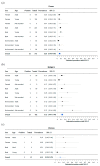Prevalence of Different Salmonella enterica Subspecies and Serotypes in Wild Carnivores in Emilia-Romagna Region, Italy
- PMID: 36496889
- PMCID: PMC9738870
- DOI: 10.3390/ani12233368
Prevalence of Different Salmonella enterica Subspecies and Serotypes in Wild Carnivores in Emilia-Romagna Region, Italy
Abstract
Salmonella is a pathogen of considerable health concern, given its zoonotic potential, and, in Italy, is the most frequently reported causative agent for foodborne outbreaks. Wild animals and in particular wild carnivores may be carriers of different Salmonella enterica subspecies and serotypes. Given their potential role as reservoirs, surveillance activities are necessary. This study aims to investigate the presence of different Salmonella subspecies and serotypes in wild carnivores in the Emilia-Romagna Region. A total of 718 fox (Vulpes vulpes), 182 badger (Meles meles) and 27 wolf (Canis lupus) carcasses, submitted between 2016-2022, were included for the present work. Gender and age data were collected along with geographical coordinates of carcass' discovery site. Contents of the large intestine were sampled and cultured according to ISO 6579-1 and both serogroup and serotype identification were performed according to ISO/TR 6579-3:2014. Salmonella was retrieved from 42 foxes (6%), 21 badgers (12%) and 3 wolves (12%), respectively. Isolated Salmonella enterica strains belonged to 4 different subspecies and 25 different serotypes. S. veneziana and S. typhimurium were the most frequent serotypes found (11/67 and 10/67, respectively). In conclusion, zoonotic serotypes were found in all these species of wildlife, thus confirming their potential role in the ecology of Salmonella spp.
Keywords: Salmonella spp.; badger; red fox; wild carnivores; wolf.
Conflict of interest statement
The authors declare no conflict of interest.
Figures



References
-
- Varela K., Brown J.A., Lipton B., Dunn J., Stanek D., Behravesh C.B., Chapman H., Conger T.H., Vanover T., Edling T., et al. A Review of Zoonotic Disease Threats to Pet Owners: A Compendium of Measures to Prevent Zoonotic Diseases Associated with Non-Traditional Pets: Rodents and Other Small Mammals, Reptiles, Amphibians, Backyard Poultry, and Other Selected Animals. Vector Borne Zoonotic Dis. 2022;6:303–360. doi: 10.1089/vbz.2022.0022. - DOI - PMC - PubMed
LinkOut - more resources
Full Text Sources
Miscellaneous

